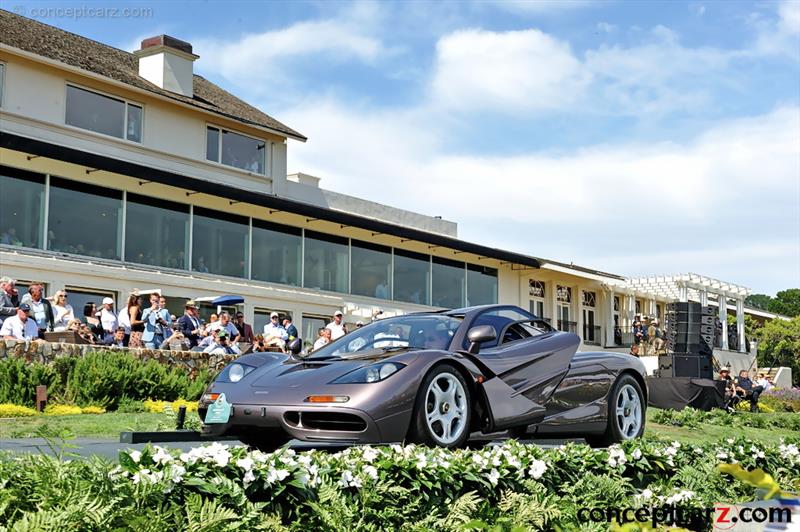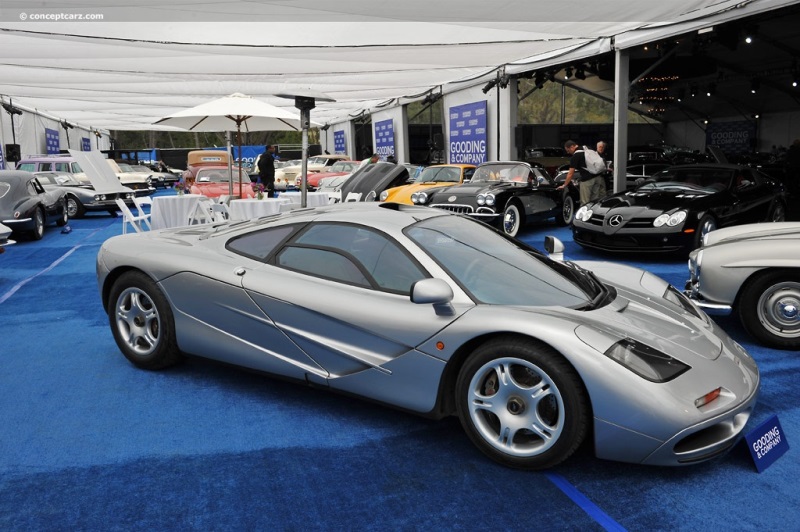The McLaren F1 was a technological tour de force created through relentless attention to detail and would remain the fastest ever naturally aspirated car for nearly thirty years. It was crafted by a company steeped in motorsport pedigree yet one that had never built a production road car. Built regardless of cost, the McLaren F1 would achieve all of the lofty goals set by its manufacturer and exceed all expectations by winning the 24 Hours of Le Mans outright in 1995, the car's first outing at the fabled event. An accomplishment made even more astonishing considering that the F1 was never designed with racing in mind, it was a watershed moment in the history of the performance automobile.
Coupe
Chassis #: 1A9MC99L9SA398062
View info and history
Auction entries : 1The McLaren F1 was the first car built with active aerodynamics, the first production car to use a carbon-fiber monocoque chassis, an early example of a production road car using a complete carbon fiber reinforced polymer (CFRP) monocoque chassis structure, a modem system so the car could communicate with technicians back at the factory to diagnose any problems remotely, and gold to reflect heat in the engine bay. Every detail was important and carefully considered, from the featherlight Falcom tool kit, the hand-drawn and inscribed owner's manuals bespoke for each car, and the six-disc CD player custom-designed by Kenwood to be the smallest and lightest unit of its kind. Aerodynamics, weight reduction, weight distribution, and meticulously engineered components were used to accomplish its goal of becoming the ultimate road car. Produced from 1992 to 1998 in Woking, England, a total of 106 examples of the Gordon Murray and Peter Stevens-designed McLaren F1s were built. This figure includes five prototypes, 64 road versions, one tuned developmental prototype (XP1 LM), five tuned versions (LM), one longtail developmental prototype (XPGT), two longtail versions (GT), and 28 racecars (GTR). Designed as a road-going supercar, designers and engineers had the complicated task of creating a vehicle that was both comfortable and performance-oriented. The contradictory purpose had to be suitable for both road and track use, offering comfort and amenities for practical applications, along with low noise and vibration, while offering the acceleration, performance and cornering abilities of a race car.McLaren F1 : Designed without Limitations
Gordon Murray was the Brabham Formula 1 designer when he was poached by McLaren in 1987 and immediately tasked by McLaren boss Ron Dennis to build the perfect production sports car, without limitations. With input from Dennis and TAG principal (and McLaren co-owner) Mansour Ojjeh, and as the story goes, Murray drew a sketch of a sleek car with the driver sitting in the center as in a Formula 1 racing car. Dennis was enthralled with the idea, and development soon commenced on the supercar that would essentially combine the technological advancements and super exotic materials of a racing car in a street legal package.
Coupe
Chassis #: 1A9MC99L9SA398062
View info and history
Auction entries : 1The aerodynamic shape had a drag coefficient of Cd=0.32, and its front area was CdA=1.79 square meters (19.3 sq ft) and the S-Cd figure was 0.57. The complexity of the McLaren F1 was evident in the approximately 5,000 individual components specially made from exotic materials. The lightweight components were an essential component of the design, complementing the aerodynamics, low drag coefficient, and high power. Materials such as titanium, kevlar, carbon fiber, gold, and magnesium were used throughout the vehicle, and it was the first production car to use a carbon-fiber monocoque chassis.Design
The McLaren F1 driver's seat was located in the middle, ahead of the engine and fuel tank, with a passenger seat slightly behind and on each side. The door design was inspired by the Toyota Sera, moving up and out when opened (butterfly or dihedral design).
Coupe
Chassis #: 1A9MC99L9SA398062
View info and history
Auction entries : 1A full eight cubic feet (227 liters) volume of luggage was available from two cool, clean side compartments just ahead of its rear-wheel arches, well away from the heat and fumes of the engine bay. The compartment doors were remote-released from the cockpit, and also provided access to the dry-sump oil tank and electrical equipment bays. Depending on the number of passengers (one or none), additional space could be utilized with the specially designed luggage developed to fit into the free seat(s), providing a further two cubic feet (56 liters) of luggage space (per seat). The hand-crafted luggage was tailored specially to optimize available space utilization, including two tall cases, two suitcases – one hanging, one slender – and a carbon-composite document case. The interior and luggage leather color schemes were customizable, and the driver's seat and steering wheel could be further personalized to color match the car body - or whatever color scheme the client preferred.The custom-made carbon and leather document case fits beneath the driver's seat. Additional interior cockpit stowage included four large 'glove boxes' and an A4-sized map pocket. A courtesy mirror is provided for passengers' use.A nose-top compartment provides space for the hydraulic reservoirs, onboard Kenwood ten-disc CD unit and the tailored titanium lightweight tool kit developed by French manufacturer Facom.Aerodynamics
The LM and GTR editions would receive a fixed wing to produce downforce, but the standard McLaren F1 was devoid of this feature. Instead, a small dynamic spoiler rested on the tail of the vehicle that automatically adjusted under braking, attempting to balance the center of gravity of the car. When the spoiler is activated, a high-pressure zone is created in front of the flap, and the pair of brake cooling intakes are opened to allow cooling air to enter.
Coupe
Chassis #: SA9AB5AC7S1048031
View info and history
Auction entries : 1The McLaren F1 used the underbody and a rear diffuser to improve downforce, along with a pair of electric Kevlar fans to further decrease the pressure under the car. An added benefit was that they directed air through the engine bay to provide additional cooling for the ECU and engine. An air intake on top of the vehicle directs high-pressure air to the engine with a low-pressure exit point at the top of the very rear. Beneath each door was a small air intake, funneling air to some electronics and the oil tank. Cooling of the front brakes was aided by front-mounted ducts assisted by a Kevlar electric suction fan.Engine
Before arriving at BMW, Gordon Murray had approached Honda requesting an engine derived from its Formula One program. Specifications requested included a block length of 23.6 inches, a total weight of 550 pounds, and a power output of 550 horsepower. When Honda declined the request, Murray approached Isuzu as they were planning an entry into Formula One and had a 3.5-liter V12 engine being tested in a Lotus chassis. Although Isuzu was interested, McLaren explored other options that had a proven design and a racing pedigree. This led them to the BMW M motorsports department, where Paul Rosche designed and built Murray a 6.1-liter (370 cubic inch) 60-degree V12 engine called the BMW S70/2. It had the block length requested by Murray, and although it was 35 pounds heavier than requested, it developed 14% more power with an output of 618 horsepower. In road-going guise, the engine had 11:1 compression, a rev limiter set at 7,500 RPM, and produced 618 horsepower at 7,400 RPM and 479 lb-ft of torque at 5,600 RPM. It had a bore size of 86 mm, a stroke of 87 mm, dual overhead camshafts with variable valve timing, and a chain drive for the camshafts. For increased performance, the camshafts are continuously variable using a system very similar to BMW's VANOS variable valve timing system for the BMW M3. At low revs, a hydraulically actuated phasing mechanism retards the inlet cam relative to the exhaust cam, reducing the valve overlap, increasing low-speed torque, and improving idle stability. The valve overlap is computer-controlled to 42 degrees at higher rpm for increased airflow into the cylinders.
Coupe
Chassis #: SA9AB5AC7S1048031
View info and history
Auction entries : 1Befitting a supercar of its stature, it used a dry sump oil lubrication system. A pair of Lucas injectors per cylinder allowed the fuel to atomize fully, with the first injector located close to the inlet valve, operating at low engine rpm, while the second was positioned higher up the inlet tract and operated at higher rpm. An ECU controlled the dynamic transition between the two devices. Each cylinder had its own miniature ignition coil. Exotic materials were used throughout the engine and engine bay, including the gold foil to reflect heat, protecting the carbon fiber body panels and monocoque, which required significant thermal insulation. Under full application, the engine produces high temperatures, and due to the temperature variation in the engine bay (from normal to full operation), CFRP (complete carbon fiber reinforced polymer) would be mechanically stressed over time from high heat transfer effects. Thus, the engine bay was not constructed from CFRP.Approximately 16 g (0.56 ounce) of gold was used in each car. Magnesium castings were used on the cam carriers, covers, dry sump, oil sump, and housings for the camshaft control. The pistons were forged in aluminum and each cylinder bore had a Nikasil coating, giving it a high degree of wear resistance.Transmission
The McLaren F1 used a six-speed manual gearbox developed in collaboration with Weismann transmissions in California. It had an AP carbon triple-plate clutch contained in an aluminum housing while the second-generation GTR edition had a magnesium housing. Both the standard road-going F1 and the F1 LM had a final drive ratio of 2.37:1. The aluminum flywheel and torsional vibration damper by BMW permitted faster gear changes and better throttle feedback. The Torsen Limited Slip Differential had a 40% lock. Specification
The McLaren F1 had a 107-inch wheelbase and an overall length of 168.8 inches. It stood 44.9 inches tall and was 71.7 inches wide. It tipped the scales at just over 2,500 pounds. Brakes
The front brakes measured 13.1 inches, and the rears were 12.0 inches. Built by Brembo, they were unassisted, vented, and cross-drilled aluminum brake discs with four-pot calipers machined from a single solid piece of metal.
Coupe
Chassis #: SA9AB5AC9S1048029
View info and history
Auction entries : 1During development, several alternative solutions were explored, including servo-assisted ABS brakes, but it was deemed too complex, reduced brake feel, and increased mass. Carbon brakes were also considered, but it was not mature enough at the time, particularly due to the initial warm-up of the brakes before being highly effective. Ceramic carbon brakes were used on the F1 GTR.Suspension
The McLaren F1 was suspended by a double wishbone system, with each wishbone machined from a solid aluminum alloy with CNC machines. The front wishbones on either side of the subframe were fixed in rigid plane bearings and connected to the body by four independent bushings. Weight Distribtuion
Forty-two percent of the car's weight was at the front and the remaining fifty-eight percent was at the rear. With a full fuel tank, this figure changed by less than one percent. Standard Equipment
Despite its supercar stature, focusing heavily on weight reduction, the McLaren F1 was well equipped with amenities rarely seen on cars of its caliber. It had a full cabin air conditioning system, SeKurit electric defrost/demist windscreen and side glass, electric window lifts, remote central locking, a tailored car cover, and a battery charger with a remote integrated connection point built-in. It had a Kenwood 10-disc CD stereo system, cabin storage compartment, cabin access release for opening panels, courtesy lights in all compartments, map reading lights, a first aid kit, a gold-plated Facom titanium tool kit, rear fog and reversing lights, and a four-lamp high-performance headlight system. There were tailored, proprietary luggage bags and a tailored golf bag, and each customer received a special edition TAG Heuer 6000 Chronometer wristwatch with its serial number scripted below the center stem.
Coupe
Chassis #: 1A9MC99L9SA398062
View info and history
Auction entries : 1The McLaren F1 did not have airbags, and the steering column was not adjustable. Instead, prior to production, each customer specifies the exact preferred position of the steering wheel, and thus the steering column is tailored by default to those owner settings. Additionally, the pedals were not adjustable but were personalized to the client's preferences before leaving the factory. The seats were handmade from CFRP and covered in light Connolly leather.Prototypes
Two prototypes were built using a pair of Ultima MK3 kit cars (chassis numbers 12 and 13). Chassis number 12 was fitted with a 7.4-liter Chevrolet V8, and number 13 had a V12. Each example tested various components, including gearboxes, exhaust and cooling system, brakes, and seats. Both were destroyed at the end of testing since McLaren did not want the car to be associated with 'kit cars.'
Coupe
Chassis #: SA9AB5AC7S1048031
View info and history
Auction entries : 1Five prototypes were built (XP1, XP2, XP3, XP4, XP5). XP1 was the original prototype and was deemed not road-legal as it had no indicators at the front. It was never publicly unveiled or painted; instead, it wore a bare carbon fiber exterior. XP1 was later destroyed in an accident in Namibia. The second prototype (painted blue), XP2, was specially built for crash testing. It did not have full interior equipment or a powertrain. The XP3 prototype, limited to 581 horsepower, was tested in August 1993 at the Nardò Ring where it achieved a calculated top speed of 231 mph from the data recording inside the car. It was used for durability testing. XP4 stress-tested the gearbox system. The British magazine Autocar was given access and tested the XP5 prototype in May 1994. Andy Wallace drove the XP5 prototype at Volkswagen's test track in Ehra-Lessien on March 31, 1998, setting a new production car world record. The record consisted of an independently measured 240.1 mph two-way average with a peak speed of 243 mph (its rev-limiter had been raised to 8,300 RPM). XP5 was the publicity car.SP3 was once owned by Gordon Murray before it was sold to a private buyer. XP4 was later sold to a private owner. XP5 is currently owned by McLaren.The car that was displayed in Monaco in 1992 was a 'Clinic Model' and was devoid of a powertrain.
Coupe
Chassis #: SA9AB5AC7S1048031
View info and history
Auction entries : 1Racing Prototypes included XP1 LM and a longtail development prototype (XPGT). Performance
The McLaren F1 was capable of sprinting from zero-to-sixty mph in 3.2 seconds and set the Guinness World Record for the world's fastest production car, reaching 240.1 mph. The previous record had been set by a Jaguar XJ220 at 217.1 mph. A naturally aspirated production car has yet to surpass the McLaren F1's top speed (cars with forced induction have exceeded the McLaren F1's top speed, but a naturally aspirated car has not). The Mclaren F1 Introduction
The McLaren F1 was unveiled at a launch show, on May 28, 1992, at The Sporting Club in Monaco. Production began in 1989 and continued through 1998. Each production example took approximately three and a half months to make.
by Daniel Vaughan | Sep 2023
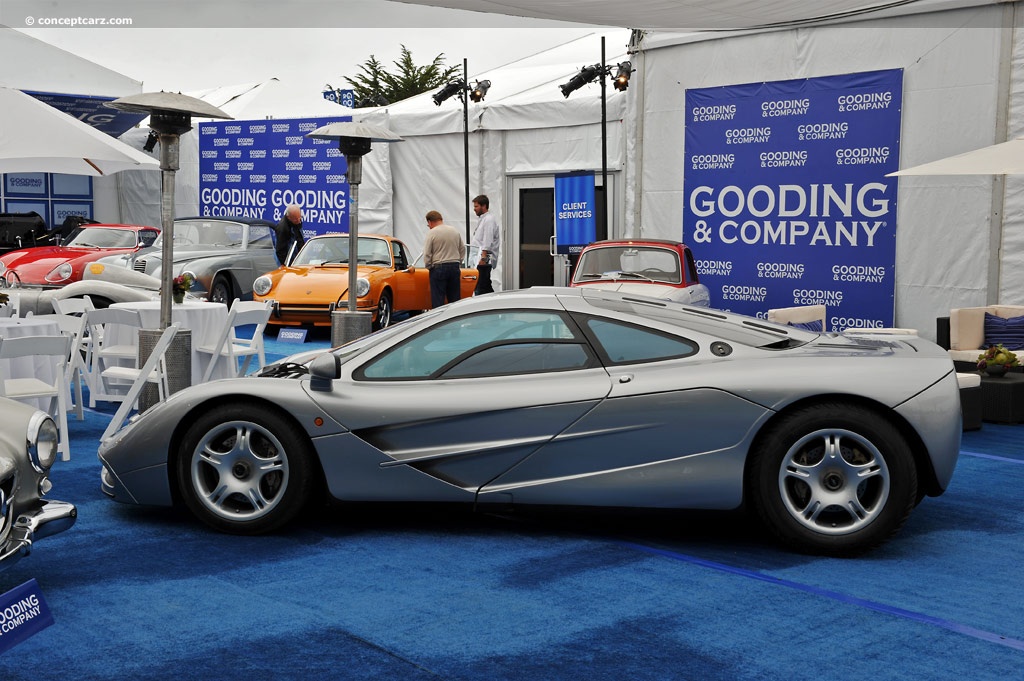
Coupe
Chassis #: 1A9MC99L9SA398062
View info and history
Auction entries : 1
Gordon Murray was the Brabham Formula 1 designer when he was poached by McLaren in 1987 and immediately tasked by McLaren boss Ron Dennis to build the perfect production sports car, without limitations. With input from Dennis and TAG principal (and McLaren co-owner) Mansour Ojjeh, and as the story goes, Murray drew a sketch of a sleek car with the driver sitting in the center as in a Formula 1 racing car. Dennis was enthralled with the idea, and development soon commenced on the supercar that would essentially combine the technological advancements and super exotic materials of a racing car in a street legal package.
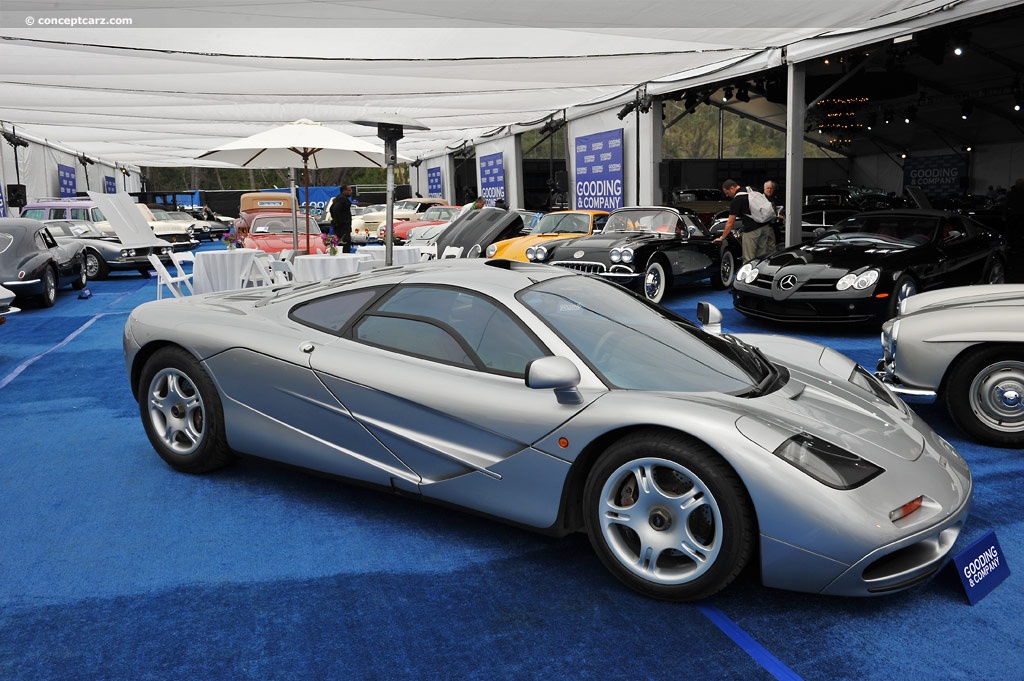
Coupe
Chassis #: 1A9MC99L9SA398062
View info and history
Auction entries : 1
The McLaren F1 driver's seat was located in the middle, ahead of the engine and fuel tank, with a passenger seat slightly behind and on each side. The door design was inspired by the Toyota Sera, moving up and out when opened (butterfly or dihedral design).
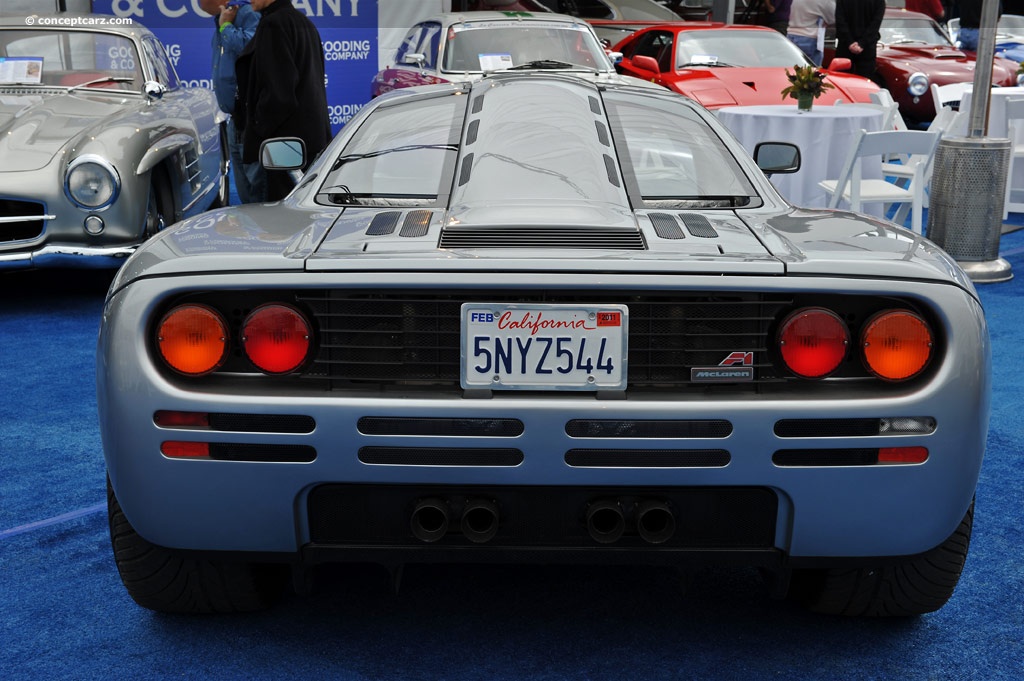
Coupe
Chassis #: 1A9MC99L9SA398062
View info and history
Auction entries : 1
The LM and GTR editions would receive a fixed wing to produce downforce, but the standard McLaren F1 was devoid of this feature. Instead, a small dynamic spoiler rested on the tail of the vehicle that automatically adjusted under braking, attempting to balance the center of gravity of the car. When the spoiler is activated, a high-pressure zone is created in front of the flap, and the pair of brake cooling intakes are opened to allow cooling air to enter.
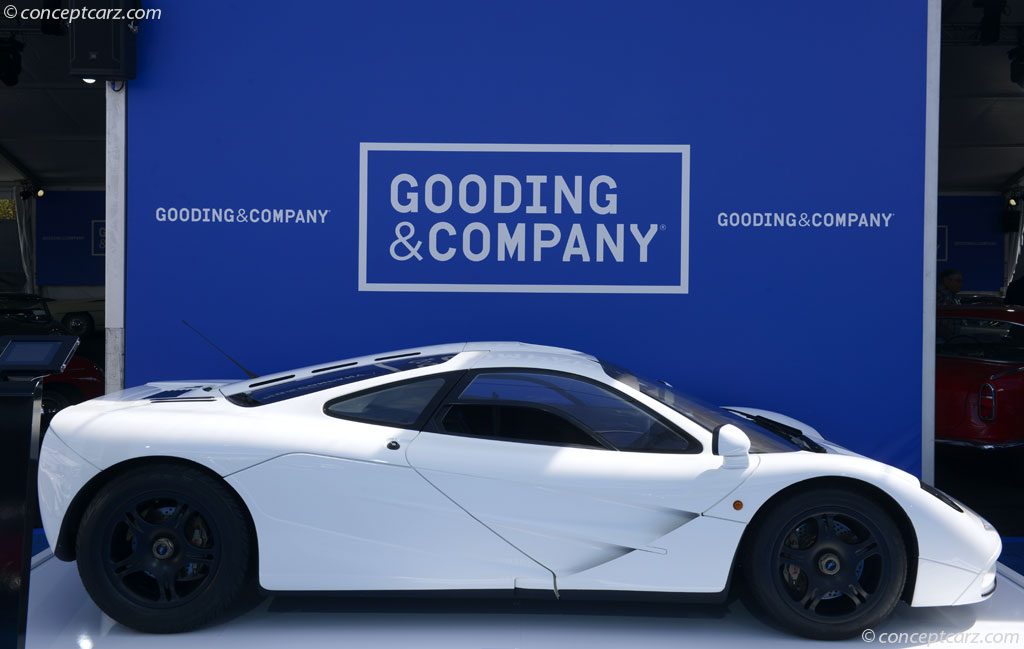
Coupe
Chassis #: SA9AB5AC7S1048031
View info and history
Auction entries : 1
Before arriving at BMW, Gordon Murray had approached Honda requesting an engine derived from its Formula One program. Specifications requested included a block length of 23.6 inches, a total weight of 550 pounds, and a power output of 550 horsepower. When Honda declined the request, Murray approached Isuzu as they were planning an entry into Formula One and had a 3.5-liter V12 engine being tested in a Lotus chassis. Although Isuzu was interested, McLaren explored other options that had a proven design and a racing pedigree. This led them to the BMW M motorsports department, where Paul Rosche designed and built Murray a 6.1-liter (370 cubic inch) 60-degree V12 engine called the BMW S70/2. It had the block length requested by Murray, and although it was 35 pounds heavier than requested, it developed 14% more power with an output of 618 horsepower. In road-going guise, the engine had 11:1 compression, a rev limiter set at 7,500 RPM, and produced 618 horsepower at 7,400 RPM and 479 lb-ft of torque at 5,600 RPM. It had a bore size of 86 mm, a stroke of 87 mm, dual overhead camshafts with variable valve timing, and a chain drive for the camshafts. For increased performance, the camshafts are continuously variable using a system very similar to BMW's VANOS variable valve timing system for the BMW M3. At low revs, a hydraulically actuated phasing mechanism retards the inlet cam relative to the exhaust cam, reducing the valve overlap, increasing low-speed torque, and improving idle stability. The valve overlap is computer-controlled to 42 degrees at higher rpm for increased airflow into the cylinders.
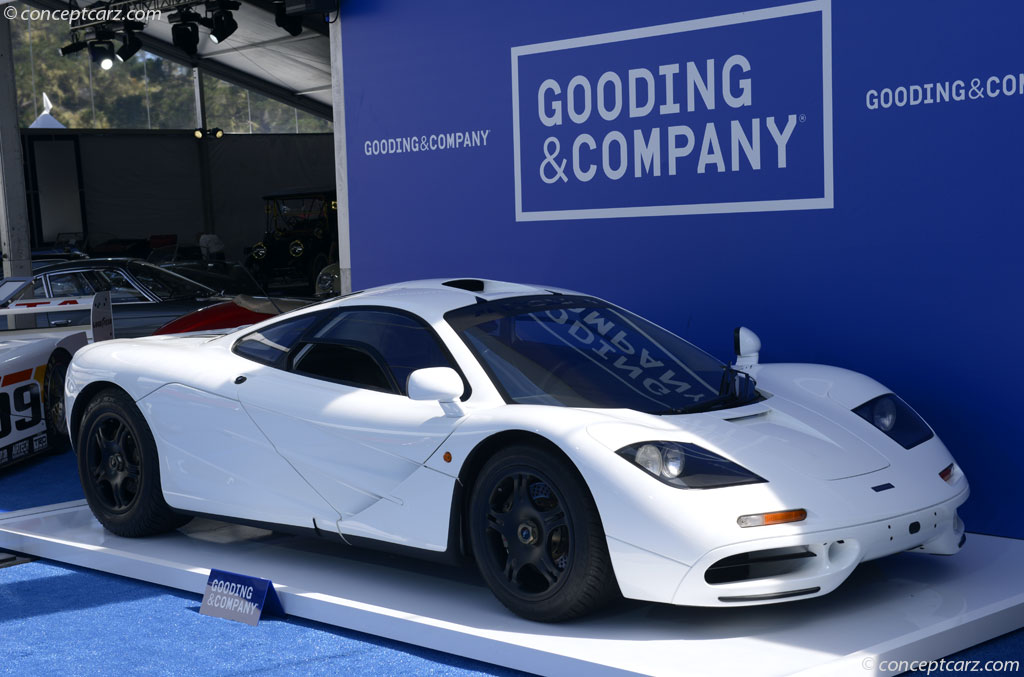
Coupe
Chassis #: SA9AB5AC7S1048031
View info and history
Auction entries : 1
The McLaren F1 used a six-speed manual gearbox developed in collaboration with Weismann transmissions in California. It had an AP carbon triple-plate clutch contained in an aluminum housing while the second-generation GTR edition had a magnesium housing. Both the standard road-going F1 and the F1 LM had a final drive ratio of 2.37:1. The aluminum flywheel and torsional vibration damper by BMW permitted faster gear changes and better throttle feedback. The Torsen Limited Slip Differential had a 40% lock. Specification
The McLaren F1 had a 107-inch wheelbase and an overall length of 168.8 inches. It stood 44.9 inches tall and was 71.7 inches wide. It tipped the scales at just over 2,500 pounds. Brakes
The front brakes measured 13.1 inches, and the rears were 12.0 inches. Built by Brembo, they were unassisted, vented, and cross-drilled aluminum brake discs with four-pot calipers machined from a single solid piece of metal.
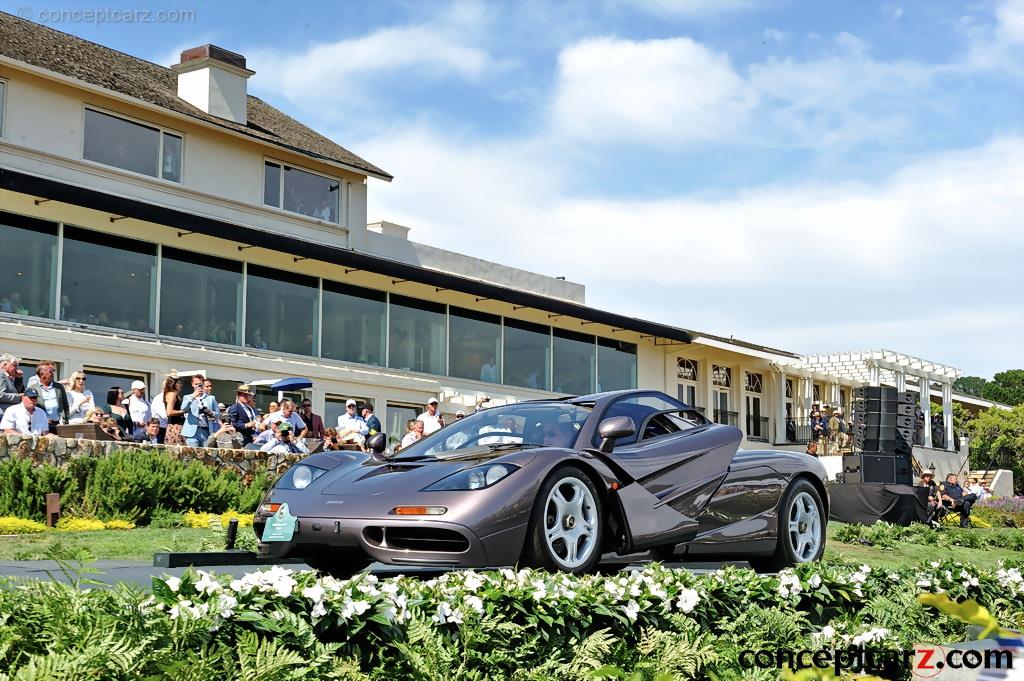
Coupe
Chassis #: SA9AB5AC9S1048029
View info and history
Auction entries : 1
The McLaren F1 was suspended by a double wishbone system, with each wishbone machined from a solid aluminum alloy with CNC machines. The front wishbones on either side of the subframe were fixed in rigid plane bearings and connected to the body by four independent bushings. Weight Distribtuion
Forty-two percent of the car's weight was at the front and the remaining fifty-eight percent was at the rear. With a full fuel tank, this figure changed by less than one percent. Standard Equipment
Despite its supercar stature, focusing heavily on weight reduction, the McLaren F1 was well equipped with amenities rarely seen on cars of its caliber. It had a full cabin air conditioning system, SeKurit electric defrost/demist windscreen and side glass, electric window lifts, remote central locking, a tailored car cover, and a battery charger with a remote integrated connection point built-in. It had a Kenwood 10-disc CD stereo system, cabin storage compartment, cabin access release for opening panels, courtesy lights in all compartments, map reading lights, a first aid kit, a gold-plated Facom titanium tool kit, rear fog and reversing lights, and a four-lamp high-performance headlight system. There were tailored, proprietary luggage bags and a tailored golf bag, and each customer received a special edition TAG Heuer 6000 Chronometer wristwatch with its serial number scripted below the center stem.
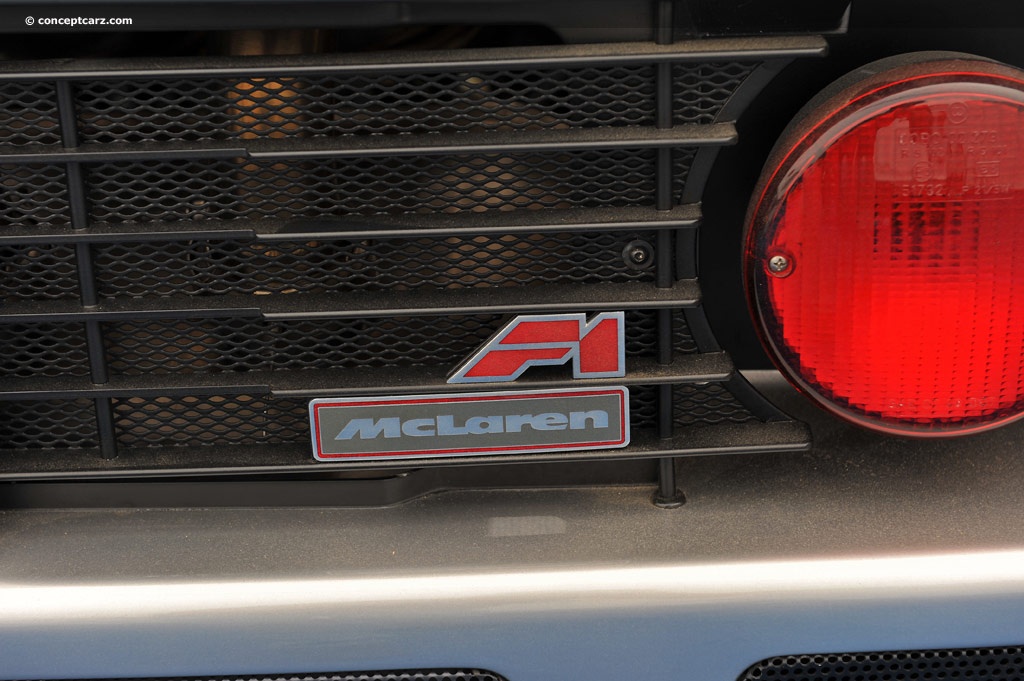
Coupe
Chassis #: 1A9MC99L9SA398062
View info and history
Auction entries : 1
Two prototypes were built using a pair of Ultima MK3 kit cars (chassis numbers 12 and 13). Chassis number 12 was fitted with a 7.4-liter Chevrolet V8, and number 13 had a V12. Each example tested various components, including gearboxes, exhaust and cooling system, brakes, and seats. Both were destroyed at the end of testing since McLaren did not want the car to be associated with 'kit cars.'
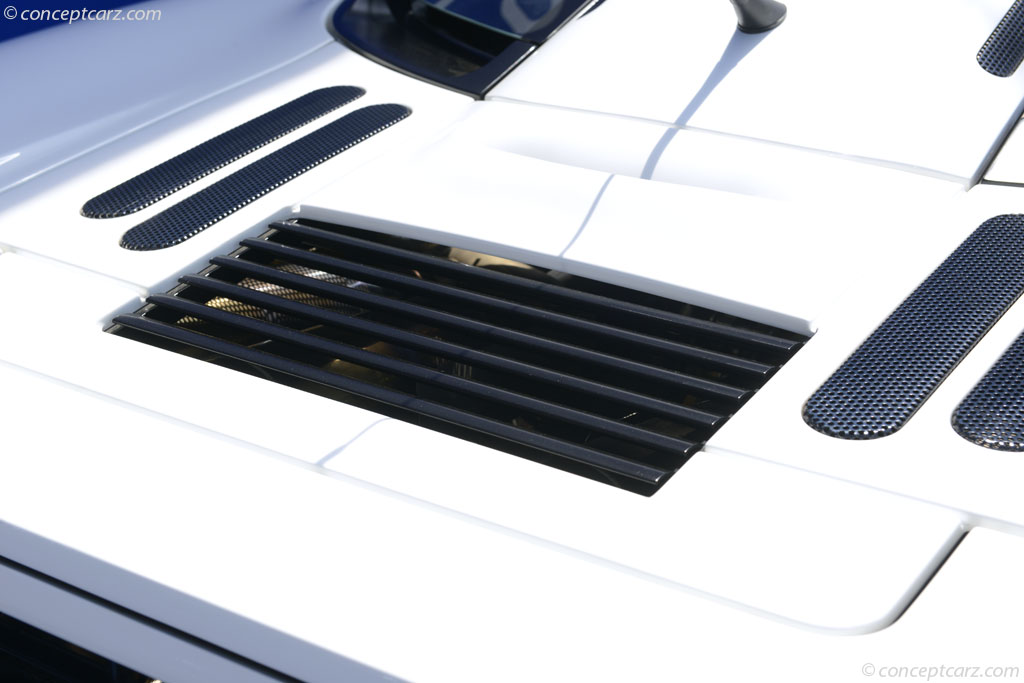
Coupe
Chassis #: SA9AB5AC7S1048031
View info and history
Auction entries : 1
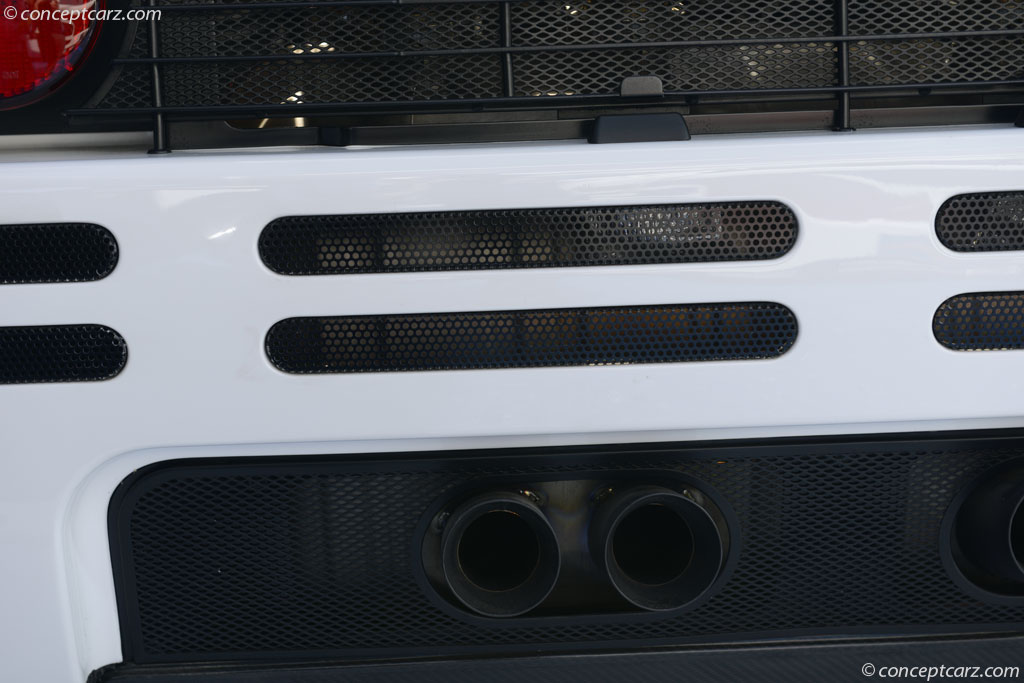
Coupe
Chassis #: SA9AB5AC7S1048031
View info and history
Auction entries : 1
The McLaren F1 was capable of sprinting from zero-to-sixty mph in 3.2 seconds and set the Guinness World Record for the world's fastest production car, reaching 240.1 mph. The previous record had been set by a Jaguar XJ220 at 217.1 mph. A naturally aspirated production car has yet to surpass the McLaren F1's top speed (cars with forced induction have exceeded the McLaren F1's top speed, but a naturally aspirated car has not). The Mclaren F1 Introduction
The McLaren F1 was unveiled at a launch show, on May 28, 1992, at The Sporting Club in Monaco. Production began in 1989 and continued through 1998. Each production example took approximately three and a half months to make.
by Daniel Vaughan | Sep 2023
FOR THE DRIVER VITALLY – AS IN ONE OF McLAREN'S WORLD CHAMPION RACING CARS – DRIVER AND VEHICLE BECOME ENTIRELY AS ONE
The primary design consideration for the McLaren F1 has been to make it without reserve a drivers car, an extremely high-performance design which advances all conventional boundaries. It combines Formula 1 racing car dynamics with genuine Grand Touring capabilities. ▪ Beginning with its radical and entirely innovative one-plus-two seating configuration, the McLaren F1 now applies several such....
Continue Reading >>
Continue Reading >>
Related Reading : McLaren F1 History
The idea for the McLaren F1 was born in an Italian airport lounge where Gordon Murray, Creighton Brown, Ron Dennis, and Mansour Ojjeh were waiting for their planes to take off. McLaren was chosen to be the builder because of their experience and proven capabilities in the sport of Grand Prix racing. Fast-forward thirty-four months and the first prototype McLaren F1 was complete. In 1993 the first....
Continue Reading >>
Continue Reading >>
Similar Automakers
1995 McLaren F1 Vehicle Profiles
Recent Vehicle Additions
Performance and Specification Comparison
Price Comparison
F1 Specification Comparison by Year
Year
Production
Wheelbase
Engine
Prices
Related Automotive News

Freshly-Restored F1 #063 To Premiere At Hampton Court Concours d'Elegance
McLaren F1 #063 on display at Hampton Court Concours dElegance has been fully restored by McLaren Special Operations (MSO)
Appearance follows announcement of McLaren F1 Certification programme at last years event
McLaren Automotive is the only b...

Emira: the most powerful four-cylinder Lotus sports car ever
Second powertrain in the Emira range extends appeal of award-winning Lotus State-of-the-art, 360bhp (365PS) mid-mounted makes Emira most powerful four-cylinder Lotus sports car of all time Eight-speed dual-clutch tran...

Abarth At The 2017 Geneva International Motor Show
Star of the event, the new Pista version of the iconic Abarth 595.
It will be joined on the stand by the numbered and limited edition Abarth 695 Yamaha XSR and the Yamaha XSR900 Abarth motorbike, which springs from the partnership between Abarth an...

THE McLAREN F1
FOR THE DRIVER VITALLY – AS IN ONE OF McLARENS WORLD CHAMPION RACING CARS – DRIVER AND VEHICLE BECOME ENTIRELY AS ONE
The primary design consideration for the McLaren F1 has been to make it without reserve a drivers car, an extremely high-performance...

2016 Lexus GS F Performance Sedan Offers a Dynamic Ride, Luxurious Comfort for Five
Latest addition to F brand stable of performance cars
Aggressive-yet-elegant exterior styling with a well-appointed interior cabin
High-revving naturally aspirated 5.0-liter V8 produces 467 Horsepower
Standard Lexus Safety System to Help Brin...

DODGE VIPER POWERS INTO 2016 WITH NEW ACR MODEL, EXPANDED CUSTOM OPTIONS AND INDUSTRY-EXCLUSIVE COLORS
New 2016 Dodge Viper ACR (American Club Racer) model returns fastest street legal Viper track car ever
New matte-finish exterior color options double the Vipers custom 1 of 1 exterior paint options to 16,000 colors and more than 50 million uniq...
























